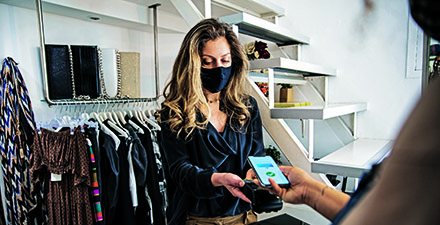Because of the health crisis with COVID-19, retailers are starting to innovate and experiment. Acceptance of online shopping and
curbside pickup has accelerated during the pandemic but how can retailers entice consumers back into stores? Retailers are deploying new strategies designed to stimulate consumer interest, loyalty and engagement as consumer behavior is reshaped by the ‘mask economy.’
Many consumers are looking to limit physical contact with potentially contaminated surfaces. For many, it’s difficult to imagine browsing alongside other shoppers, trying on clothes, going into a store to ‘test-drive’ the latest gadget touched by others and interacting with another human at checkout.
Contactless technologies offer businesses a winning strategy by allowing the public to feel safer during their shopping journey, from ordering, browsing, checkout and payment to delivery.
During the pandemic, 30% of consumers started using contactless payments like NFC-equipped cards, smartphones and wearables to pay for a purchase, according to RTi Research. Some retailers are investing in virtual ‘try-ons,’ self-cleaning surfaces and robots. There are also other products based on technologies like voice interaction, gesture interfaces, facial recognition, sensor-based and RFID technologies, or companion apps that use a consumer’s own smartphone to operate a public device.
September/October 2020
More articles in this issue:
- A Tech to Watch: The 5G Rollout
- EV Connective Series: What’s Going On in this Arena?
- The New Workplace, What Comes Next?
- Faces of Innovation: Inder Singh, CEO of Kinsa

Remote service in-store will reduce browsing times and offer advice remotely. Experiential retailer SHOWFIELDS is using the Magic Wand app. For the instore experience, the app serves as a virtual store advisor to minimize human interaction. Consumers point their phones at displays and products to get more information rather than interacting directly with the product. Customers can also add items to a virtual cart while in the store before checking out via its app. The purchase is ready for pickup when they leave the store.
Inventory tracking is getting smarter, thereby reducing employee contact with items. Apps from companies like Displaydata and EDITED help retailers optimize promotions and reduce contact for shoppers hunting for merchandise. Touchscreens are everywhere — from ATMs to self-service supermarket checkouts — but in the age of COVID-19 consumers may be reluctant to touch these public devices.
Screens, kiosks and vending machines are being retooled to reduce human interactions. PopCom, the automated retail platform company, is developing an alternative way to deliver product. By delivering a software solution that makes kiosks and vending machines intelligent, PopCom enables retailers to provide customers with seamless access to their products, while also gaining customer insights based on data collected from facial recognition, AI and blockchain technology that is incorporated into its software platform.
“COVID has changed PopCom’s business,” says Dawn Dickson, its founder, CEO and director. “Retailers are looking for more frictionless transactions and they need to move faster. Vending machines are increasingly part of the new supply chain since the transaction is about self-checkout, self-service and frictionless payment,” she adds.
PopCom has pivoted to upgrading its touchscreens to be contactless, allowing them to be used with a pen or a stylus or while wearing gloves. PopCom is rolling out its solutions to the retail sector in the fourth quarter as well as into the regulated retail economy including cannabis, pharma, alcohol and tobacco. It also plans to license its intelligent software platform.
Aside from current challenges, a byproduct of this disruption at retail are the exciting new opportunities
for retailers, smaller businesses and brands as well as nimble entrepreneurs and innovators.


